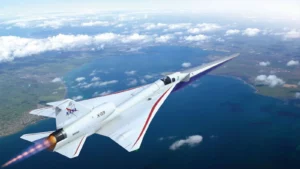In January, over a hundred attendees gathered in a California airplane hangar to witness NASA unveil its X-59 jet.
This futuristic aircraft, designed to surpass the speed of sound, has reignited excitement for supersonic travel.
Since the Concorde’s last flight in 2003, supersonic jets have been largely military-bound.
However, NASA’s X-59 unveiling, a collaboration with Lockheed Martin, comes as several private companies aim to reintroduce supersonic flights to commercial travel.
Companies like Boom, Exosonic, and Spike are promising quieter, greener, and more cost-effective supersonic travel than before.

Hermeus is even exploring hypersonic flights, potentially cutting NY-London trips to 90 minutes.
Yet, the feasibility of these promises remains questioned amid aviation’s economic challenges and environmental concerns.
Here are five key insights into the revival of supersonic travel:
1. Softening the Sonic Boom
NASA’s X-59 aims to reduce the sonic boom to a mere thud.
By redesigning the aircraft’s shape and engine placement, NASA hopes to prove supersonic speeds can be achieved without disruptive noise.
This could lead to the lifting of US bans on overland supersonic flights, making them financially viable.
2. Private sector interest
Despite the focus on eco-friendly transport, about half a dozen companies are racing to offer supersonic travel to the public.
Denver-based Boom Supersonic targets 2029 for its passenger jet, Overture, which promises speeds over twice those of standard planes.
3. Sustainability Promises
Companies claim their jets will be more sustainable, using aviation fuel from agricultural products.
However, the limited availability and higher cost of sustainable fuel, coupled with the inherently higher fuel consumption of supersonic jets, pose significant challenges.
4. Making Supersonic Travel More Accessible
Today’s entrepreneurs believe supersonic travel can eventually become more accessible to a broader audience, unlike the Concorde, which was prohibitively expensive for most.
5. The Quest for Even Faster Travel
Atlanta’s Hermeus is exploring hypersonic commercial flights that could dramatically reduce travel times.
While facing technological hurdles, the prospect of Mach 5 speeds offers a glimpse into an even faster future.
As these initiatives progress, they must navigate technological, economic, and environmental challenges to make supersonic and hypersonic travel a reality.

